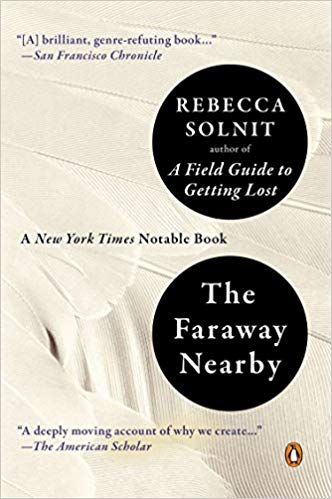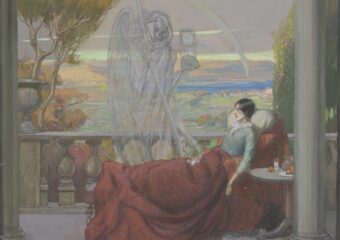Rebecca Solnit
Penguin Books
New York
2014
254 pages
According to the Art:
Through fourteen stories, Solnit tells of her experiences with her mother’s dementia, a friend’s cancer, and her own cancer. Some stories about these experiences and other stories are about other events in her life at the same time. She provides thoughts on experiencing particular illnesses, American health care, and how illness figures in the stories of our lives.
Synopsis:
Solnit dares the reader to categorize her book. Autobiography, memoir, travelogue, story collection, history, meditations, and pathography could fit. Common to all the categories and subjects covered is storytelling. “It’s all in the telling… and to be without a story is to be lost in the vastness of the world,” Solnit says in the book’s opening. Storytelling can bring what is geographically faraway emotionally nearby.
Solnit’s first and last stories lay the foundation for the others in between. Both center on the hundred pounds of apricots she received from one of her brothers who was getting their mother’s house ready for sale when dementia made it impossible for her to live alone. Solnit saw “the apricots as an exhortation to tell of the time that began with their arrival, and so the stories concern the time from when they arrived onward” (p. 240). Solnit considers this time when her mother’s dementia is worsening an “emergency,” but in this instance, she conceives emergency as “an accelerated phase of life, a point at which change is begotten, a little like a crisis” (p. 250). The book to her, she says, is “a history of an emergency and the stories that kept me company then” (p. 249).
The topics covered during this emergency are many and varied, related and unrelated. Just some of them are: her mother’s dementia, her own cancer, her friend’s cancer, leprosy, Che Guevara as physician and revolutionary, Iceland, the Arctic, Mary Shelley’s Frankenstein, Buddhism, and cannibalism. In general terms, illness, pain, empathy, fairytales, and reading and writing are considered. Some of these topics are intertwined and some stand alone.
The book is organized into thirteen numbered “stories.” Each has a one-word title. The titles of the first five stories are the same as the last five in reverse order, i.e., the first and last stories are both called “Apricots.” They are arranged on the table of contents page to form the shape of a bell curve that has been rotated ninety degrees with the apex of the rotated curve comprising the stories, “Wound,” Knot,” and “Unwound.” Threads run through the stories, and perhaps Solnit is telling us the story threads running through the first six stories are wound into a knot and then unwound in stories running through the last six of them. This structure may be more grist for people interested in how literature can be structured than for people interested in the insights into illness experiences literary nonfiction can provide.
Not among the list of stories is one that is printed as a single line running along the bottom of each page in the book. It’s a story about stories running along side the other stories. In an interview printed in the 8 August 2013 issue of Harper’s Magazine, Solnit said she used this form in part to invite “readers to decide how to read a book that has two narratives running parallel to each other; the thread can be read before, during, or after.”
Analysis:
The book offers people with serious interests in literary forms of storytelling a lot to consider and study. Separately, the book offers people interested in literary nonfiction perspectives on health problems from many angles.
Her mother’s dementia was the primary inspiration for Solnit’s book. Many of the experiences she covers are noteworthy, not because they are rare, but because they are different than more common perceptions or composite pictures of dementia. For one, Solnit did not come willingly to her role as her mother’s caregiver through the natural progression of a loving relationship. She had a tense and troubled relationship with her mother, whom she resented and held in utter contempt. Solnit was on a path leading her farther away from her mother until…
…I realized that my mother had done all these things for me before I remembered. I was fed; I was washed; I was clothed; I was taught to speak given a thousand other things, over and over again, hourly, daily, for years. She gave me everything before she gave me nothing.
p. 29
It was in honor of that unremembered past that I took care of her, that and the principle and solidarity with my brothers.
For another, where children of parents with dementia often feel they have lost a parent, Solnit experienced the opposite—her mother “felt more like a parent than she ever had, in that she was affectionate and enthused about me” (p. 226). And, whereas some people with dementia lose memories of painful experiences and have to go through them again and again (e.g., forgetting the death of a spouse), for Solnit’s mother, “Liberated from the burden of her past, things became incomparable, each slice of cake the most delicious cake ever, each flower the most beautiful flower…and was often almost giddy with enthusiasm” (p. 225).
Solnit’s observations on the progression of her mother’s dementia are familiar insofar as they reflect serial regressions in behaviors and capabilities. What isn’t familiar is how in one instance she conjures the complex, but stirring imagery of a palimpsest as it would look in reverse to render this pattern of regressions.
I thought of my mother as a book coming apart, pages drifting away, phrases blurring, letters falling off, the paper returning to pure white, a book disappearing from the back because the newest memories faded first, and nothing was being added. The words were beginning to vanish from her speech, leaving blank spots behind.
p. 10
During this time, Solnit confronted her own health problem, suspected breast cancer, and through this experience discovered what it’s like to be a patient and to be subjected to the indignities of health care.
You must be patient, must become a patient, must take up residence in waiting rooms, must learn to wait for experts and results, must grow accustomed to being laid out upon tables and invaded, described in unfamiliar language, and treated with methods that may seem like illnesses and injuries though they are intended to cure.
p. 94
Where Solnit likens being ill to being placed in another country and on the dark side of the moon, her writing recalls analogies Susan Sontag and Virginia Woolf once made about their illnesses. But, she offers some updates to these observations based on how cancers are now often discerned through molecular biology. The biological analysis of her biopsy showed that what was found in her breast may not be a cancer like it once would have been considered, and that may never become a cancer. She wonders whether with these test results she “will qualify as a cancer survivor,” (p. 119) and whether she will “be cured of more than [she] had been diagnosed with” (p. 121).
Solnit’s analysis of illness goes further yet. The narrative, the telling, as Solnit conceptualizes illness, can spark imagination and emotional engagement that shapes the experience: “An illness is many kinds of rupture from which you have to stitch back a storyline of where you’re headed and what it means. Every illness is narrative” (p. 138). Her illness as narrative is not to be confused with the “medical narrative,” which has a narrower application in its use in Medicine for clinical evaluations of individual patients. Her conception of illness as narrative adds to Peter Barritt’s list of other conceptions: illness as loss; illness as change; illness as experience; and illness as questions.*
Also:
*Peter Barritt, Humanity in Healthcare: The Heart and Soul of Medicine (Oxford: Radcliffe Publishing, 2005), 73-85.
A version of this post is here at the NYU Literature, Arts and Medicine Database.



